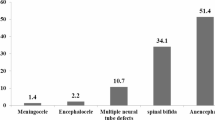Abstract
Background
Maternal first cousins of an individual with a neural tube defect (NTD) are at increased risk for an NTD. It is not known if they are also at risk for other serious birth defects.
Methods
We carried out an interview study of uncles and aunts and first cousins in Irish NTD families covering their pregnancy histories and the health of family members.
Results
Maternal first cousins were more likely than paternal first cousins to have a birth defect (9.4% vs. 5.5%, p = 0.02; adjusted odds ratio: 1.72, 95% confidence interval: 1.04, 2.84).
Conclusions
This study shows that two generations of distant relatives (uncles/aunts and first cousins) in NTD families have similar maternal excesses of NTDs and birth defects overall. Inheritance mechanisms favouring matrilineal transmission, currently unknown, may contribute to birth defect occurrence in these families.

Similar content being viewed by others
References
Chatkupt S, Jaggi M, Mitruka BS et al (1994) Study of genetics, epidemiology and vitamin usage in familial spina bifida in the United States in the 1990s. Neurol 44:65–70
Byrne J (2008) Birth defects in uncles and aunts from Irish families with neural tube defects. Birth Defects Res A Clin Mol Teratol 82(1):8–15
Williamson E (1965) Incidence and family aggregation of major congenital malformations of the central nervous system. J Med Genet 2:161–172
Carter CO, David PA, Laurence KM (1968) A family study of major central nervous system malformations in South Wales. J Med Genet 5:81–93
Carter CO, Evans K (1973) Spina bifida and anencephalus in greater London. J Med Genet 10(3):209–234
Zackai EH, Spielman RS, Mellman WJ et al (1978) The risk of neural tube defects to first cousins of affected individuals. UCLA Forum Med Sci 20:99–102
Lippman-Hand A, Fraser FC, Biddle CJ (1978) Indications for prenatal diagnosis in relatives of patients with neural tube defects. Obstet Gynecol 51(1):72–76
Nevin NC, Johnston WP (1980) A family study of spina bifida and anencephalus in Belfast, Northern Ireland (1964 to 1968). J Med Genet 17(3):203–211
Hunter AGW (1984) Neural tube defects in Eastern Ontario and Western Quebec: demography and family data. Am J Med Genet 19(1):45–63
McManus S (1987) Neural tube defects: identification of ‘high risk’ women. Ir Med J 80(6):166–168
Toriello HV, Higgins JV (1983) Occurrence of neural tube defects among first-, second-, and third-degree relatives of probands: results of a United States study. Am J Med Genet 15(4):601–606
Khoury MJ, Erickson JD, James LD (1982) Etiologic heterogeneity of neural tube defects. II. Clues from family studies. Am J Hum Genet 34(6):980–987
Opitz JM, Gilbert EW (1982) CNS anomalies and the midline as a “developmental field”. Am J Med Genet 12(4):443–455
Macintosh MC, Fleming KM, Bailey JA et al (2006) Perinatal mortality and congenital anomalies in babies of women with type 1 or type 2 diabetes in England, Wales, and Northern Ireland: population based study. BMJ 333(7560):177
Doolin MT, Barbaux S, McDonnell M et al (2002) Maternal genetic effects, exerted by genes involved in homocysteine remethylation, influence the risk of spina bifida. Am J Hum Genet 71(5):1222–1226
Chatkupt S, Lucek PR, Koenigsberger MR et al (1992) Parental sex effect in spina bifida: a role for genomic imprinting? Am J Med Genet 44(4):508–512
Whitelaw E (2006) Epigenetics: sins of the fathers, and their fathers. Eur J Hum Genet 14(2):131–132
Acknowledgments
The author expresses her sincere appreciation to the families which participated in this study, to Susan Carolan, Dorothy Collins, Rose Ryan, Clodagh Byrne, Suzanne Markey, Mark Harmon, David Carroll, for expert technical assistance data, and especially to Yvonne Byrne, interviewer for this study; and to Sonia Stoszek and Dilys Parry for their careful reading of the manuscript. I acknowledge with gratitude grants from the Drogheda and District Charity Chest and from the Joseph E. and Marjorie B. Jones Foundation in partial support for this study.
Author information
Authors and Affiliations
Corresponding author
Electronic supplementary material
Below is the link to the electronic supplementary material.
Rights and permissions
About this article
Cite this article
Byrne, J. Birth defects among maternal first cousins in Irish families with a neural tube defect. Ir J Med Sci 179, 375–380 (2010). https://doi.org/10.1007/s11845-009-0381-x
Received:
Accepted:
Published:
Issue Date:
DOI: https://doi.org/10.1007/s11845-009-0381-x




